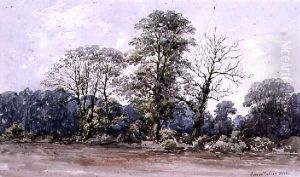George Wallis Paintings
George Wallis was a notable English artist, born in 1811 in Wolverhampton. He was known to have played a significant role in the fields of art, design, and education during the Victorian era. His career was multifaceted; he was not only a painter but also a designer, museum curator, and educator. Wallis was one of the key figures in the Arts and Crafts movement and was deeply involved in the development of public art education in Britain.
Wallis showed an early interest in the arts and was apprenticed to a japanner (a craftsperson who applies a type of lacquer finish) in his hometown. This initial training would influence his later work in both design and fine arts. In the 1830s, he moved to London to pursue his career as an artist and designer. He exhibited his work at the Royal Academy and the British Institution, which were the leading art institutions in Britain at the time.
Throughout his career, Wallis was deeply committed to art education. He believed that good design was integral to manufacturing and industry, a philosophy that resonated with the principles of the Arts and Crafts movement. He took an active role in teaching, and in 1843, he became the headmaster of the Manchester School of Design. Later, he was involved in the South Kensington Schools system, which became the Royal College of Art.
In addition to education, Wallis made significant contributions to the development of museums. He was appointed as the first Keeper of Fine Art Collection at the South Kensington Museum (now the Victoria and Albert Museum) in London. During his tenure, he worked on expanding the museum's collection and presenting it in a way that was educational for the public.
George Wallis's legacy is not only in his artworks but also in his lasting impact on art education and museum curation. His dedication to the improvement of design standards and his belief in the educational power of art helped to shape the direction of British art institutions and influenced the next generations of artists and designers. He passed away in 1891, leaving behind a rich legacy that bridged the gap between the worlds of art creation, education, and preservation.





